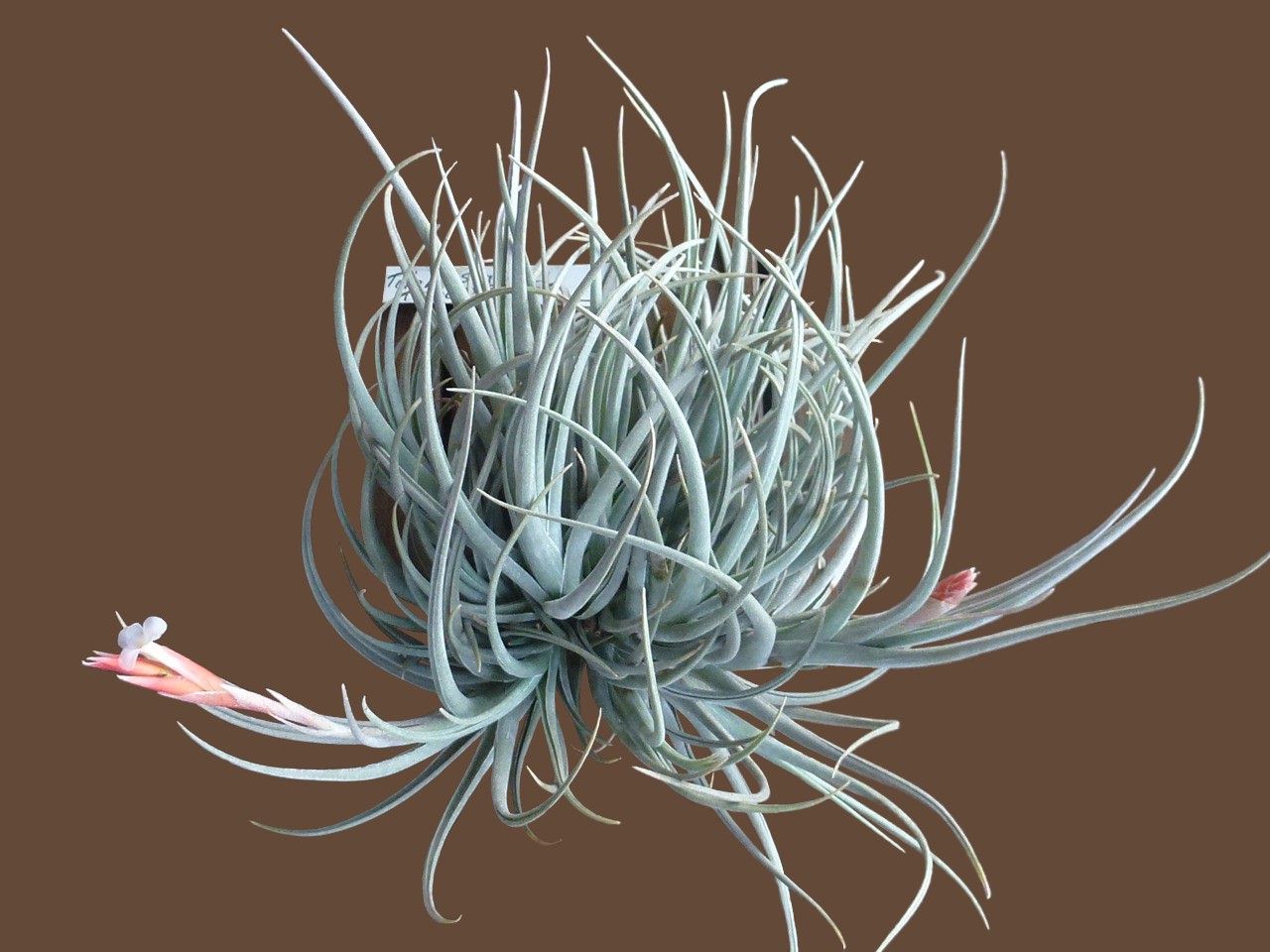
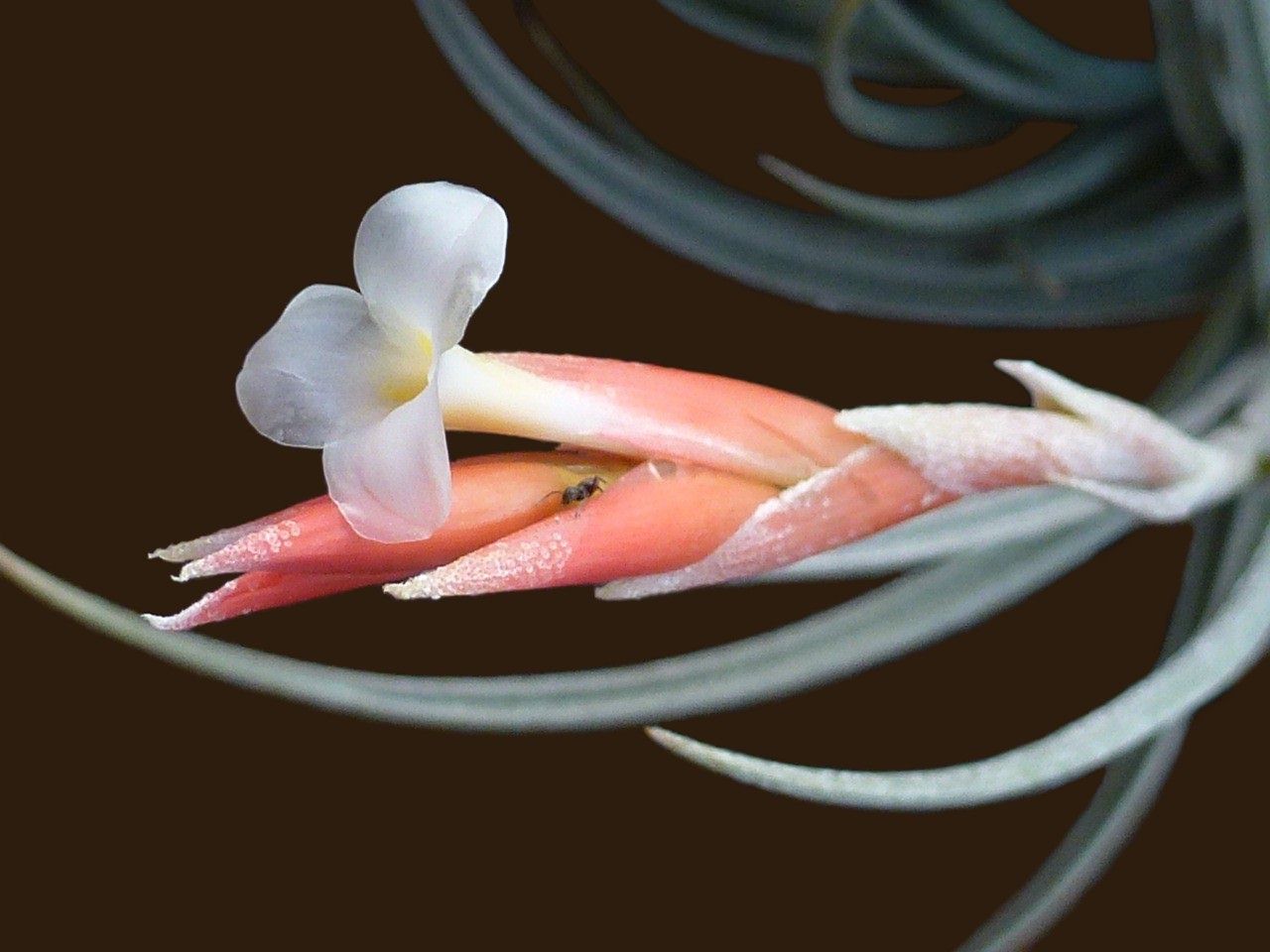

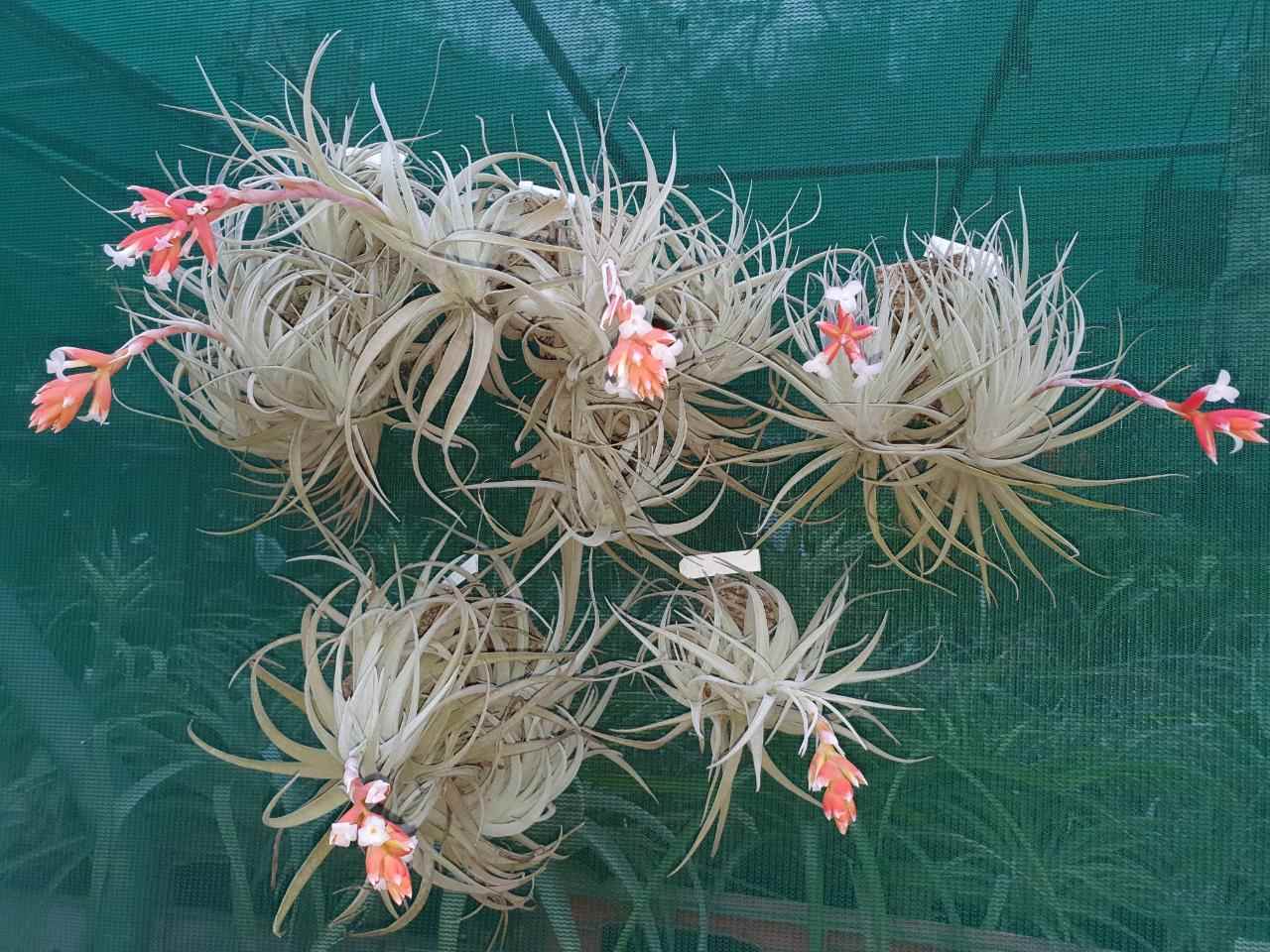
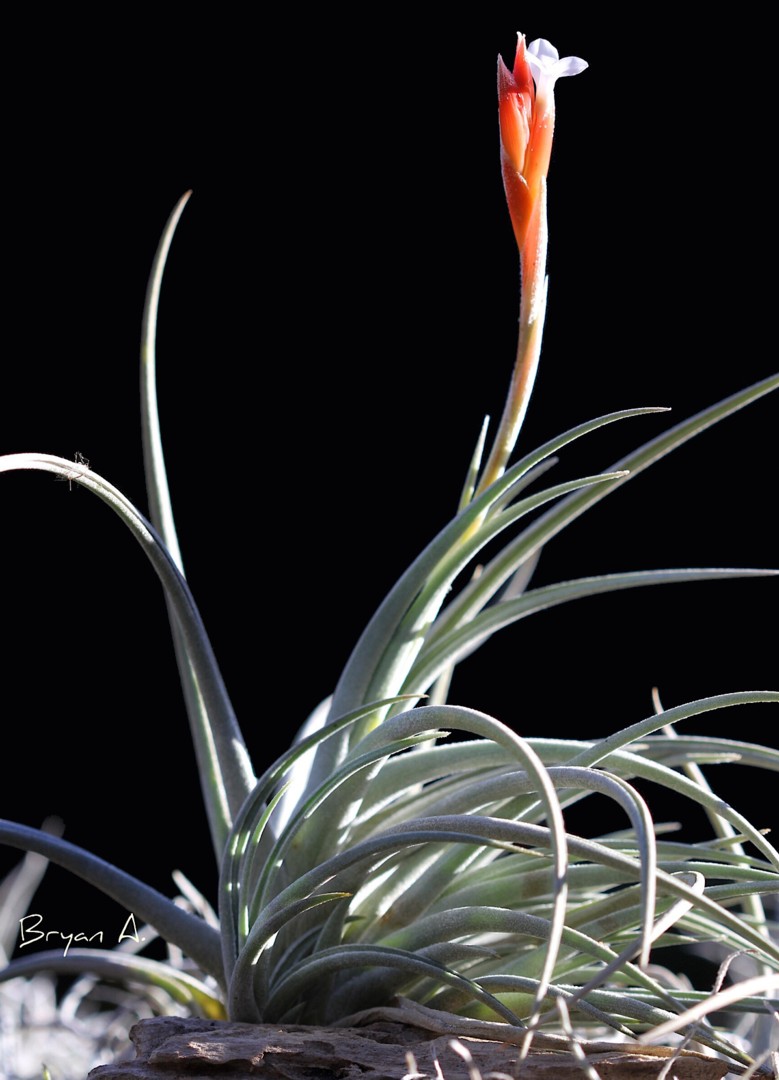
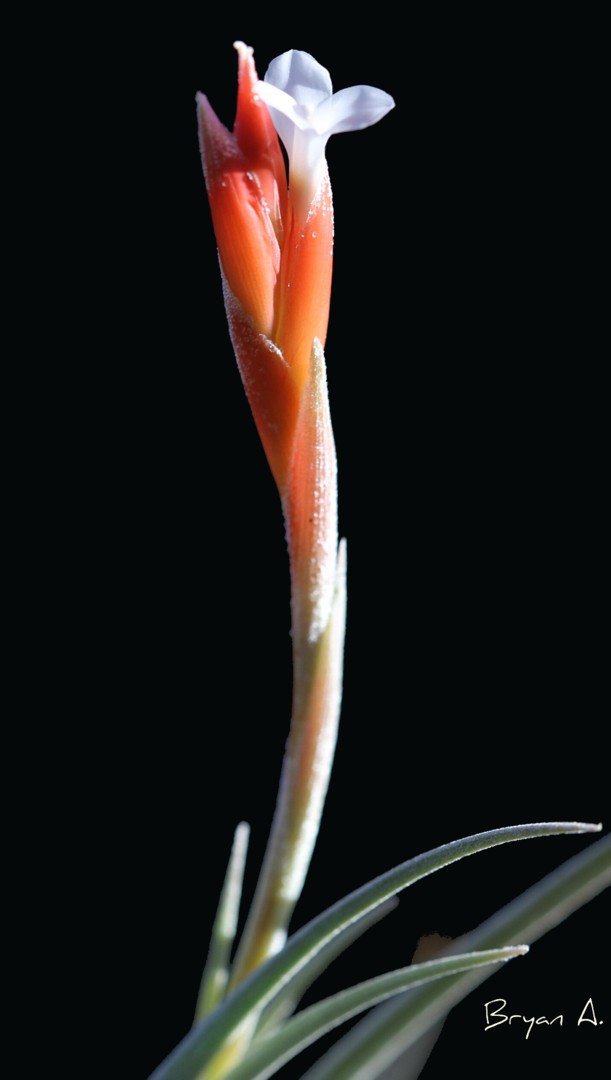
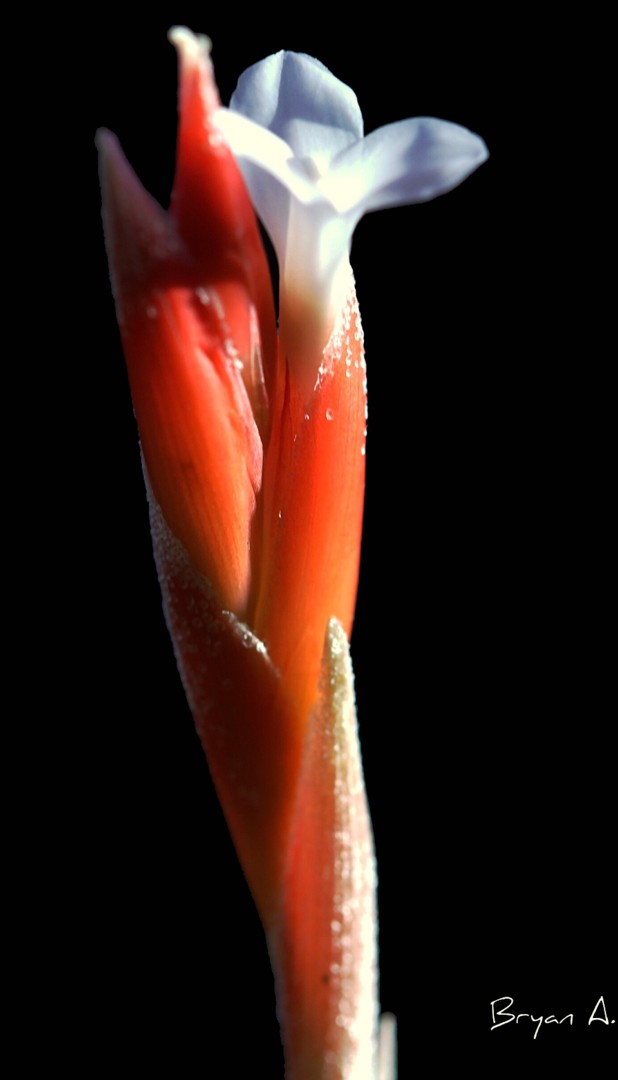
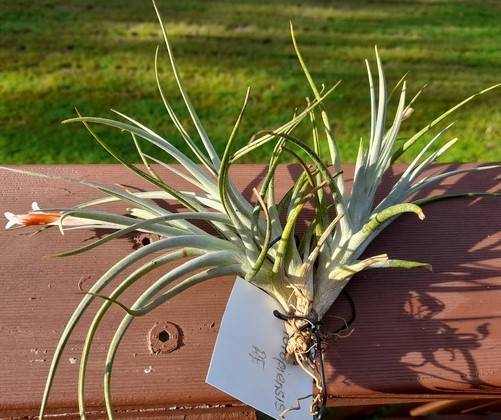
Translated from the German by Butcher.
Plant making a large clump to 1m diam., single plant with long stem, many leaved, polystichous, flowering to 25cm high and to 30 (- 40)cm diam.., including the lower leaves.
Leaf sheath indistinct, longish-oval, to 4cm long and 1.5cm wide, top side of the bottom portion naked and a lively green, the upper portion with the underneath densely lepidote and strikingly pleated.
Leaf blade thin triangular at the bottom succulent and strongly channelled, with a long filiform reflexed tapering tip, to 25cm long, near the sheath ca. 1.5cm wide, both sides densely grey lepidote, scales weakly eccentric with green centre, at the leaf edge long winged.
Scape to 15cm long, erect to horizontal, shorter than the leaf rosette, 3 – 4cm thick, green, naked.
Scape bracts leaflike at the bottom, dense grey lepidote, the upper ones similar to the flower bracts with longer sheath and shorter blade, pale cinnabar-red, at the tip densely scaled
Inflorescence simple, to 20cm long, erect, or spreading horizontal.
Spike to 3.5cm long and 1.5cm thick, complanate, with 3 – 5 flowers spiralling but distichously arranged at the tip.
Flowers to 3cm long, white, sessile.
Rhachis visible, naked, green edged, fragile.
Floral bracts erect, long lance-like, short tipped, closely adjacent to the petals, not keeled, to 2.8cm long and 8mm wide, smooth, pale cinnabar-red, lepidote at the tip, widely exceeding the sepal.
Sepal to 17mm long, tapering to a sharp reddish tip, the posterior ones sharply keeled and joined for 14mm.
Petals white, tongue shaped, with broad reflexed dull platte.
Stamens and Style deeply enclosed . Filament flat ribbon like, the upper section strongly cross pleated. Anther yellow 4mm long. Style with very short lobes, shorter than the anthers.
Ovary green, cone shaped, 3mm high.
Holotype Rauh 56 059 ( 9 Sep. 1981) HEID
Habitat growing in the ground between rocks near River Toropi with Notocactus magnificus, Lepismium cruciforme, Billbergia nutans, at 300m (Prov. Rio Grande do Sul, Brazil)
Known only from Type locality
Emails
3 Sep 2001
Dear Derek, Len asked about T. toropiensis, you may be interested:
As to the T. toropiensis:
I gave you and as far as I know also to Eric plants of this spec. I have 2 clones. One was given to me by Werner Rauh and is the type-clone Nr. Rauh 56059 from Rio Toropi. And I have a second clone from Rio Toropi collected by Thieken 3 years later, as well at Rio Toropi.
After a plant from the type-collection flowered in my collection I wrote to Werner Rauh that the inflorescence is not a complanate spike with distich flowers at the top but it is a polystichous infl. like T. araujei or T. nuptialis. Werner did not agree.
Then I sent Thieken to the Rio Toropi and got plants from him. It is very sure that he was at the same location as Werner and Thieken went with Horst and both reported that T. toropiensis is growing with Notocactus magnificus. These plants from Thieken also flowered polystichous. I told this to Werner and asked him to correct his description. But he said: then Thieken found a second new spec., my plant has distichous flowers. I sent a photo of a flowering T. toropiensis to Mr. Piepenbrink the Bromeliad-gardener of the Botanical Garden and he wrote to me:"our plant in the garden is exactly flowering like yours" (I still have his answer in my papers).
So it is absolutely the real T. toropiensis which you got and the photo toropi 2 is exactly like my plants, no doubt.
The other plant Eric made a drawing, but I did not see a photo, from Lydia? I do not know without seeing a photo.
Lydia got from me a number of T. toropiensis, so she has the correct thing. But what she sold with what name of course I do not know. But I know she sold T. cochabambae which were not.
But much more of my interest is: What is the difference of the inflorescences of T. araujei, T. spec. Moro de Coco, T. spec. Maria Magdalena, and T. toropiensis?????
Don’t you agree this is a more difficult question? The question what is T. toropiensis is much easier to answer, don’t you think so?
31 Aug 2001
Tillandsia toropiensis
Dear Len, Derek,
Genus: Tillandsia, Species: toropiensis, Author: Rauh
Publication: Trop. Subtrop. Pflanzenwelt 50:10-3 Date: 1984
Distribution: Brazil:Rio Grande do Sul. Type:
Holo:HEID}.
Relations: T. nuptialis Ribu Braga & Sucre
There are some differences with the plant I have from Rauh 56059 (clonotype), see drawing attached. The flower seems to be more robust and the spike is more flowered. I do not know whether this can be the conditions.
31-8-2001:
Eric,
It originated from Renate. That is all I know.
It is very similar to the plant of the fcbs web site shown also as T. toropiensis.
However, that plant (Derek's photograph on the web) has a quite different history. We ordered some plants from Lydia Koehres which she listed as T. cochabamba. However, what we got was nothing like T. cochabamba. The nearest we could come to was T. toropiensis. But this does raise some interesting questions.
Lydia is fairly knowledgeable, and it would be surprising if she got the wrong country. The plants she thought were T. cochabamba surely did not come from Brasil, the habitat of T. toropiensis. Because you mentioned Bolivia, I wonder where the plants from Lydia really originated. Bolivia or Brasil?
Hence, there are three questions.
1. Where did Renate's plant (that we just sent to you) come from?
2. Where did Lydia's plant (on the fcbs web page) come from?
3. Are either of them the true T. toropiensis?
I still have yet another source of what is meant to be T. toropiensis, but that is another story. Regards, Len.
13/04/2006
Dear Lotte et al,
Now I got a plant from Lydia Koehres, Peru, Knize 1993 Nr. 211, Acabamba, that flowered in her collection. Enclosed scan of plant and infl. postfloral, and photos Koehres.
Any idea? for me it looks strange.
Sincerely, Renate
20 Apl 2006
Renate
We have been discussing this plant in OZ and I believe it is the same as what Adam imported from Kohres as T. cochabambae some years ago. I have photos of this plant in flower as well as photos of T. toropiensis (on the label), and all three forms look very similar. Now we have a problem because there is a Acobamba in Peru and this is a long way from Rio Grande do Sul. This is beginning to smell like the T. pucarensis/guelzii saga where similar plants were allegedly found in far apart places. Eric Gouda has T. toropiensis and his provenance detail may be more accurate than Rauh's. The only difference I could see between our 'Cochabambae' and Eric's T. toropiensis was that our plant had posterior sepals joined about half whereas his are almost totally connate, the filaments are pleated in the one I took to pieces. Renate will be able to confirm that T. pucaraensis leg. Thieken differs slightly from the protologue. I know she has offsets from the type collection but they would have come from Rauh!!
To think that in 2001 we thought we had solved this problem with a short burst of Emails! Derek
20 Apl. 2006
Dear Derek,
Unfortunately our Tillandsia toropiensis is from Heidelberg too (R56059: Brazil, Est. Rio Grande do Sul, near Toropi outlet; Sep. 1981.). Sepals highly connate (11 of the 15 mm). I have all flower details here.
I once got a T.toropiensis flower from Len (the second specimen I ever saw) that originated from Renate (see message from Len 31-8-2001 below). This one has larger flowers (sepals 19 mm and only half connate) but certainly looks like a T.toropiensis.
Best, Eric
20 Apr 2006
Eric,
I enclose scans of T. toropiensis. You can be sure, that this is the real plant as I have a part of the type-clone and as well plants leg Thieken at Rio Toropi. As Thieken went with Kurt Horst, who also was with Werner Rauh at the Rio Toropi, it is evident, that both collections are the same plant. When the plants leg Thieken flowered in my collection I called Werner Rauh and told him, that the plants do not at all flower distich. But he said, his plant had a nearly distichous spike. I sent Piepenbrink a photo of my flowering plant with polystichous infl. and he sent a card telling me: our plants flower the same way. My plants have the sepals connate for about half the length.
Lydia is going to bring her plants to Leipzig, so I can see them. At the moment I only have the one postfloral plant of Knize 211.
I am going to ask Lydia, if the label could have been changed.
Renate.